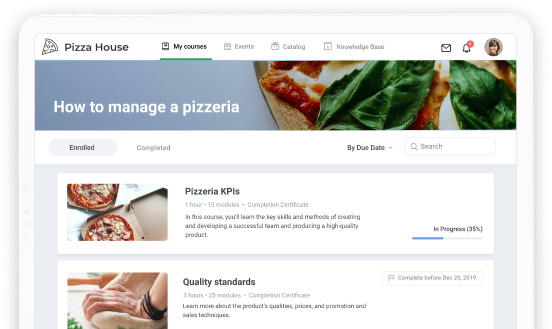The Best Online Learning Platforms in 2024

Since the tech boom of the late 1990s, online learning has skyrocketed in popularity as a way to teach and train. It stands out for its unparalleled convenience, flexibility, and affordability in a world that has become increasingly expensive and busy.
With its growing appeal, online learning platforms have become hot items on the global stage. However, selecting the ideal one is no easy task! The market has become flooded with a wide variety of online training solutions, and each one comes with its own set of unique features.
This article provides an in-depth look at various online learning and course platforms, including their advantages and disadvantages, pricing, why we included it on our list, and who it’s a best fit for. Prepare to discover your ideal choice among the best online learning platforms!
What Is an Online Learning Platform?
An online learning platform is a digital space where course creators can promote, sell, and distribute their eLearning courses. These platforms are commonly known as “online course marketplaces.”
Similar to conventional schools, these digital tools provide learners with a secure space to access course content, engage in learning, and interact with instructors and fellow students.
These platforms come with an extensive array of features, such as lectures, assignments, quizzes, interactive learning experiences, certificates of completion, and social forums. So, in a way, “learning platform” is sort of a catchall term for both businesses and learners.
They help in the creation, organization, marketing, and processing of payments for your courses, while also offering all necessary tools and educational resources that learners need in a single, convenient location.
Online Learning Platforms vs. Online Course Platforms vs. LMSs
It’s common to mix up learning platforms, online course platforms, and learning management systems (LMSs), yet distinguishing between them is important.
As mentioned, online learning platforms are more like marketplaces that center around the viewpoint of the learners, or “buyers.” That’s because they take on the bulk of the work in promoting your courses, expanding your audience, and developing your sales funnel. Therefore, the focus here is on the front-end aspect of your business – the course marketplace and the courses it offers.
However, taking on the bulk of the work incurs expenses. For example, if your goal is to achieve the utmost flexibility in your structure and functionality in terms of collecting and analyzing user data, then you’ll find your options somewhat limited. That is especially so if you’d like to personalize your online courses with adequate branding.
Conversely, online course platforms place greater emphasis on back-end operations. They typically offer cloud-based software centered around instructors, allowing for the creation not just of courses, but also engaging learning environments.
For example, you can upload diverse educational content and organize it into learning paths. Numerous course platforms also provide the tools to establish your marketplace – that is, your own sales funnels, pricing plans, memberships, and revenue. What’s more, you gain control over critical user analytics, branding, and marketing techniques, all designed to amplify your business’s expansion.
As for learning management systems (LMSs), their emphasis shifts away from sales and marketing towards the efficient delivery of training to large groups of learners, employees, or partners, for example.
In contrast to online educational platforms, many LMSs come equipped with built-in course creation tools, facilitating the development of new online courses. Besides, LMSs allow you to manage users, assign content to them, and track learner progress, all from a single interface.
Ultimately, an LMS can be viewed as a more advanced type of course platform, granting you extra freedom and flexibility in terms of the types of training materials you can create and the degree of engagement you can integrate.
Grasping the distinctions among learning platforms, course platforms, and LMSs will help you narrow down the extensive array of eLearning solutions. But even after deciding on a particular type of platform, there are still many choices to be explored. Keep reading to discover what they are.
Also read → 12 LMS Benefits — Expert Opinion
Best Online Learning Platforms in 2024 (Team Picks)
Here are our team’s picks of the top online learning platforms, carefully selected to meet diverse educational needs:
Here are our team’s picks of the top platforms, carefully selected to meet diverse educational needs:
Best learning platform for businesses: LinkedIn Learning
It has excellent quality control to ensure instructors are subject matter experts with excellent teaching skills.Best online educational learning platform: edX
This one partners with the world’s top universities and organizations to offer learners courses of the highest quality.- Best LMS for businesses: iSpring Learn
This one ticks all the LMS boxes, providing automatic grading, learner tracking, insightful analytics, and more. - Best online course platform: iSpring Market
It provides a perfect balance between offering amazing flexibility and customization in course creation and having great digital marketing features. Best learning platform for schools and colleges: Moodle
It has a variety of features that encourage students to take part in online learning, such as gamification and interactive course content.
Best Online Learning Platforms for Businesses in 2024
Do you need to upskill your employees? Online learning platforms for businesses can help your employees gain new skills or enhance existing ones to serve your business better.
Moreover, they can be more cost-effective than traditional training methods.
The best eLearning solutions for businesses include:
1. Udemy Business
G2 rating: 4.5/5 (595 reviews)
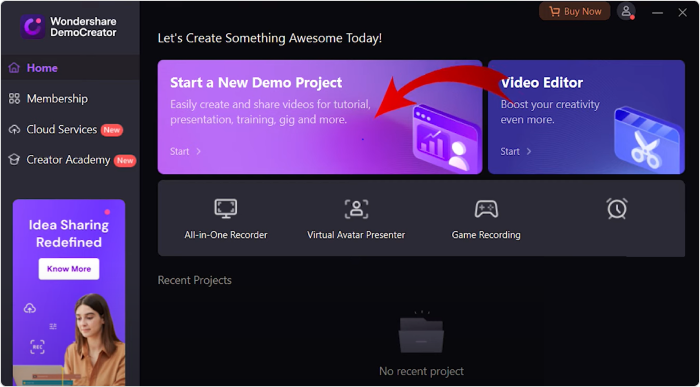
If you’ve ventured into the realm of eLearning, you’ve undoubtedly come across giants such as Udemy or Udemy Business, which rank among the top online learning platforms. Udemy Business provides access to over 14,000 training courses for more than 9,500 companies, covering a broad spectrum of subjects.
As a training platform for business, it excels in offering courses focused on skill development. Experts can seamlessly upload their video courses — including screencasts, talking-head videos, and video presentations — and monitor the progress of trainees, analyze data, and extract valuable insights. Unfortunately, the platform does not have built-in features for creating content; all content must be developed externally.
Virtually anyone has the opportunity to teach on Udemy. While this means many instructors are specialists or deeply passionate about their subjects, this also opens the door to quality control issues.
In any case, Udemy Business stands out as an excellent option if you aim to connect with a broad audience as an instructor. Its extensive user base simplifies the process of marketing and earning from your courses. For training managers or businesses seeking to enhance their team’s skills, Udemy Business fits the bill.
Pros
- User-friendly interface
- Quality control measures
- Issuance of completion certificates
- Compatibility with various LMSs
Cons
- Absence of built-in tools for course creation
- Limited to video-based course content
- Primarily passive learning experience due to minimal interactivity
- Certificates may not be recognized by employers
Who is it for?
- L&D professionals and business owners: Udemy Business is the top choice for L&D experts or business owners seeking to educate their workforce without the resources or budget to develop bespoke courses. With its extensive selection of courses focused on practical hard and soft skills, and cost-effectiveness, it offers educational content suitable for nearly every need.
- Instructors: Udemy Business provides instructors with a platform to reach a broad audience, offering opportunities to share expertise and educational content with professionals and learners in various fields.
However, if your employees require highly specialized skills specific to your business, there’s no assurance that the available courses will meet these unique needs adequately. Overall, it’s a top online learning platform for business teams seeking more general skills.
Why we picked it
Udemy ranks among the most expensive platforms, branding itself as “the leading global marketplace for learning and instruction.” And since it offers over 213,000 courses to a community exceeding 59 million learners, we think that’s a pretty fair assessment.
Pricing
Udemy Business offers three pricing plans:
- Team (5-20 users): $360 per user/year
- Enterprise (21+ users) and Leadership Academy (groups of 25 or more):
Contact sales for a custom quote
Offers a 7-day free trial.
Also read: 5 Udemy Alternatives: What Else is Out There?
2. Skillshare
G2 rating: 3.3/5 (40 reviews)

Much like Udemy, Skillshare is a major online eLearning platform. It offers over 35,000 courses to more than 5 million learners, focusing on creative fields like graphic design, animation, photography, and videography. So, its learner base mainly consists of individuals, entrepreneurs, and small businesses.
Another feature that sets it apart is its emphasis on collaboration and social learning. Learners can share their assignments, allowing others to like, comment, and ask questions. This helps foster inspiration and elevate creative skills.
If you’re aiming to become part of Skillshare’s community of over 8,000 instructors, the platform enhances the experience by offering the latest resources and teaching tools tailored to your course topic.
Pros
- Active learner community with social interaction
- Extensive selection of training courses
- Detailed engagement and analytics insights
- Broad range of marketing integrations
Cons
- Limited to video-based courses only
- No LMS integration
- Doesn’t offer certificates
- Quality assurance can be difficult due to the open instructor policy
Who is it for?
- Businesses in the creative industry: For companies involved in design or employing visually creative talents, Skillshare stands out as an excellent resource for skill enhancement. It offers a wide range of relevant courses. It’s also one of the few eLearning tools that allows users to share their creations and interact with peers and instructors, making it an ideal venue for finding inspiration through collaboration.
Why we picked it
What stands out for us about Skillshare is its focus on community engagement. In contrast to other educational platforms, it encourages learners to interact with each other, creating an experience that resembles an interactive classroom rather than solitary video viewing.
Pricing
Skillshare has a 3-tiered pricing plan:
- Starter (2-19 users): $159 per user/year.
- Enterprise (20-50 users): Contact sales for a custom quote.
- Revive (51+ users): Contact sales for a custom quote.
Offers a 1-month free trial.
3. LinkedIn Learning
G2 rating: 4.4/5 (658 reviews)

The merger of Lynda.com with LinkedIn in 2017 gave birth to LinkedIn Learning. Catering to fields of creativity, business, and technology, this platform provides access to over 16,000 courses to its massive user base of over 700 million individuals. Learners can enhance their abilities in almost any field, whether it’s marketing, course development, or time management skills.
LinkedIn Learning is considered one of the best online learning platforms due to its thorough instructor selection process. This ensures that educators are not only experts in their respective fields but also have outstanding teaching and presentation abilities. As such, quality control and the excellence of its offerings are unparalleled.
The platform excels in delivering a high level of engagement through quizzes and practice exercises that participants can complete alongside their microlearning videos.
Moreover, it stands out as one of the best online training tools that offer certification. Upon course completion, learners receive a certificate, which they can prominently display on their LinkedIn profile. Even though LinkedIn Learning courses lack formal accreditation, the certificate of completion can significantly enhance your profile and open up new business opportunities.
In essence, this platform provides exceptionally high-quality educational material.
Pros
- Expertly vetted instructors
- Caters to different learning styles
- Enhanced engagement through interactive practice exercises and quizzes
- Certificates of completion that can be showcased on your LinkedIn profile
Cons
- Lack of direct interaction with instructors or peers
- Narrow range of course subjects
- No LMS, marketing, or analytics integrations
- Courses do not carry formal accreditation
Who is it for?
- Individuals who lead busy lifestyles: The platform’s support for microlearning courses provides unparalleled freedom and adaptability. It’s a perfect choice for businesses training staff remotely or for busy individuals and entrepreneurs seeking self-directed learning opportunities to enhance their skills in business, technology, and creative fields.
Why we picked it
We appreciate the platform’s micro-learning approach and its interactive nature. But the best part is that instructors have to demonstrate expertise and exceptional presentation skills. On this platform, passion alone doesn’t suffice.
Pricing
LinkedIn Learning offers a monthly and annual plan as an all-access pass for individuals.
- Annual: $26.99/month
- Monthly: $39.99/month
If you’re interested in pricing for teams, you’ll need to contact them for a custom quote.
Offers a 1-month free trial.
Top Online Educational Learning Platforms in 2024
Are you a student seeking to acquire a recognized degree or certification while studying at your own pace? Or do you represent an educational institution looking for a platform for course delivery so students can access lectures and learn remotely? Online educational learning platforms are created for you.
The best online educational platforms are the following seven:
4. Coursera
G2 rating: 4.5/5 (353 reviews)
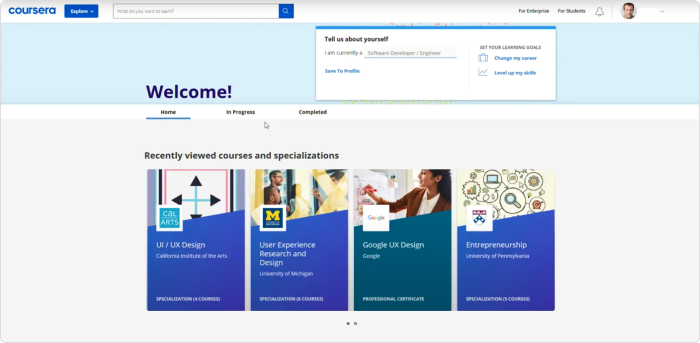
Coursera primarily serves as an online educational platform targeting academic institutions. It provides a wide range of online degree programs, including bachelor’s and master’s degrees, specializations, and certificates, many of which are accredited by globally renowned universities.
Boasting over 5,000 courses, partnerships with more than 200 businesses and universities, and a community of over 77 million learners, Coursera has significant influence in the eLearning domain. Its course catalog is particularly strong in business and scientific disciplines, including computer science, data science, health sciences, and physical sciences.
Previously, Coursera required all instructors to be top-tier educators or professors affiliated with its partner institutions, guaranteeing high-quality content from experts in the field. However, their criteria have become more flexible in recent times. Still, to offer training courses on Coursera, a deep understanding of your subject matter is essential!
Pros
- Well-organized, high-quality university courses
- Accompanying transcripts for videos
- Certificates of completion valued by employers and institutions
- Financial assistance is available for learners with low incomes
- Adheres to a traditional academic approach to learning
Cons
- Limited range of topics (mainly business and science)
- Some courses are time-bound with specific start and end dates
- Direct interaction with instructors for questions or feedback is often limited
- For assignments that require peer review, it could take a long time for the reviews to be made, which means you might have to wait longer for your certificate of completion while continuing to pay for your monthly subscription
Who is it for?
- Students looking for recognized certificates of completion: Coursera is an ideal choice for students seeking high-quality education on a reputable platform that provides valued certificates of completion and even university diplomas. With a broad user base that includes over 100 Fortune 500 companies, more than 6,000 college and university campuses, and numerous government institutions, Coursera has become a trusted resource for learning and professional development.
Why we picked it
We consider Coursera to be one of the most prestigious educational platforms. By collaborating with leading universities and organizations, it offers learning programs taught by top experts in various fields.
Pricing
Coursera Plus Annual (access to all courses): $399/year
Offers a 7-day free trial.
5. edX
G2 rating: 4.5/5 (111 reviews)
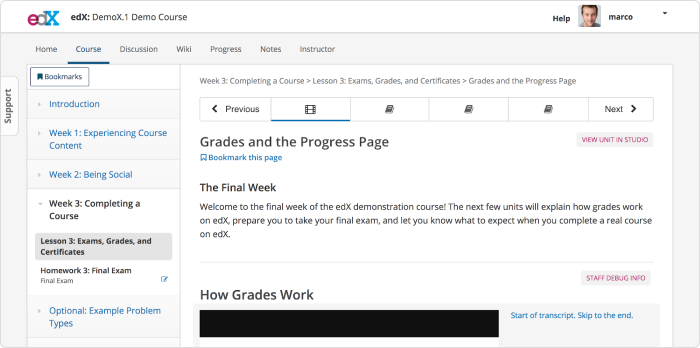
If you are seeking formal education opportunities, edX is a worthwhile platform for you. As a mission-driven provider of massive open online courses (MOOCs), edX collaborates with renowned universities and organizations worldwide, such as Harvard, Berkeley, and IBM, to offer exceptional online courses to learners globally.
Just like at a university, you have access to a wide range of course topics, including architecture, art and humanities, sciences, linguistics, medicine, business, and economics.
edX provides over 3,000 courses, including free options, organized into 300 programs. While it offers a diverse selection of topics, its course catalog may be considered smaller in comparison to other online platforms we have reviewed. However, it provides a remarkable level of interactivity through graded assignments and offers verified, accredited certificates.
If you’d like to be an instructor but are not associated with one of edX’s 160+ partner institutions, consider exploring other options. Only faculty and staff members from edX’s partner schools are allowed to create and sell courses on the platform.
Pros
- Certificates of completion from highly recognized accredited institutions of higher education
- Courses from prestigious institutions such as Harvard and MIT
- Flexible, self-paced learning options available for most courses
- A diverse selection of course topics and learning programs
- A partially free platform that lets you audit courses
- Financial aid options are available for low-income learners
Cons
- A lack of consistency in course structure because partners can create courses as they see fit
- A relatively small selection of courses compared to other platforms
- The interface may be perceived as cumbersome by some users
Who is it for?
- Individuals who want formal education-style learning: edX is designed to replicate the structure and rigor of traditional education, making it an ideal choice for university and college students seeking a flexible yet high-quality learning experience. The platform primarily appeals to individuals pursuing accredited courses from reputable institutions of higher education, as the content is academically focused rather than being geared toward professional development.
Why we picked it
Similar to Coursera, edX is a reputable platform for education and learning. Its courses are developed and instructed by prestigious universities and renowned companies globally, ensuring exceptional quality, so the quality speaks for itself. What we also like is that, upon successful completion of a course or program, learners are awarded a certificate of completion from an accredited university.
Pricing
- edX: While edX offers free courses, the “Verified Track” route (with paid courses) can range from $50 to $300, depending on the course(s) you enroll in. If you’re pursuing a master’s degree (which has more courses), this can go as high as $10,000–$25,000.
- edX for Business: For groups (small teams or businesses): $349 per learner/year. For enterprises (large organizations): Contact sales for a custom quote.
6. Khan Academy
G2 rating: 4.5/5 (179 reviews)
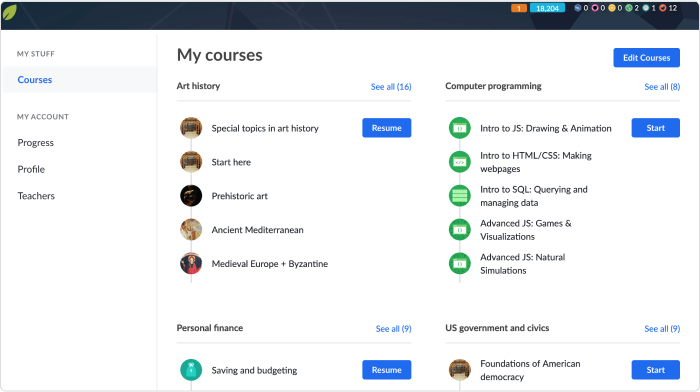
Khan Academy is an eLearning platform that provides students with a free, world-class education. Backed by some of the largest foundations and businesses in the world, Khan Academy has taken the world by storm since its fairly recent inception.
It has a wealth of tutorial videos covering various subjects, although mathematics is the most comprehensively covered subject.
Pros
- Absolutely free to use
- Offers a variety of subjects
- Allows learners to study at their own pace
Cons
- Its video tutorial is less interactive than face-to-face tutoring
- Uses a fairly formal interface that won’t get anyone excited
Who is it for?
- Students seeking a free resource to supplement their learning: Khan Academy challenges students to practice and master skills using videos and hints as support. Thus, while it can be used as the main source of instruction, it’s more suited as a supportive resource.
Why we picked it
Khan Academy content is organized by grade level, making it easy to target students at a particular skill level. The platform also has powerful analytical features that enable you to track students’ progress.
Pricing
Khan Academy is absolutely free.
7. MasterClass
G2 rating: 4.3/5 (13 reviews)

MasterClass is an online learning platform that promises to help you “learn from the best to become the best.” It truly ‘goes the extra mile’ to deliver courses with people who have expert knowledge or skill in the particular subject.
From photography courses taught by celebrity photographer Annie Leibovitz to culinary courses taught by celebrity chef Gordon Ramsay, MasterClass has a roster of celebrity instructors.
It offers 185+ classes organized into 11 categories, covering food, design and style, music, art and entertainment, wellness, business, and more.
Pros
- Very engaging lessons
- High-quality video
- Highly skilled and experienced instructors
- Relatively affordable
Cons
- No free trials
- Does not provide completion certificates
Who is it for?
- Anyone who wants to be taught by famous faces: If you are an enthusiast in a particular topic and want to learn from someone who is famous in that field, then MasterClass is for you. For instance, they have a class called “Disruptive Entrepreneurship” taught by Sir Richard Branson.
Why we picked it
MasterClass’s videos are well-produced and a pleasure to watch. Plus, the bite-sized approach they use optimizes learning outcomes.
Pricing
MasterClass offers three plans:
- Individual membership (1 device): $10 per month
- Duo membership (2 devices): $15 per month
- Family membership (6 devices): $20 per month
8. Udacity
G2 rating: 4.5/5 (736 reviews)
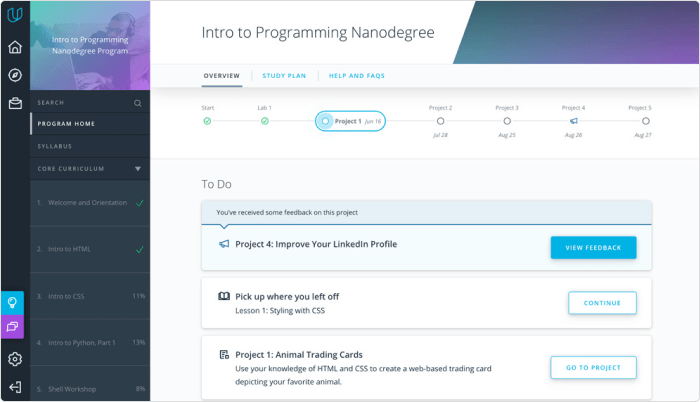
Udacity is one of the most popular MOOC (massive open online course) platforms out there. It offers an intuitively organized interface. Courses on the platform are geared toward specific careers, especially in computer science and IT. But it’s still great for creating highly structured university-level eLearning.
Pros
- Intuitive course interface
- Instructors are available for live mentoring
Cons
- Pays a fixed price for content development instead of per sale, so there’s no way to generate passive income
- Uses subscription-based pricing, and prices are significantly higher
Who is it for?
- Individual course instructors: Udacity’s payment is based on course completion rather than sales. So, it is tailored to individual course instructors. If you’re a business hoping to train employees, you should look elsewhere.
Why we picked it
Udacity gives you great exposure. It will offer your courses to its wide user base, meaning you’ll do less marketing. While its “fixed price” payment isn’t great, it provides opportunities for revenue-sharing based on the number of learners enrolled in your course.
Pricing
Udacity’s subscription cost:
- $249 per month
- $2,390 per year (20% saving)
9. Pluralsight
G2 rating: 4.6/5 (1,013 reviews)
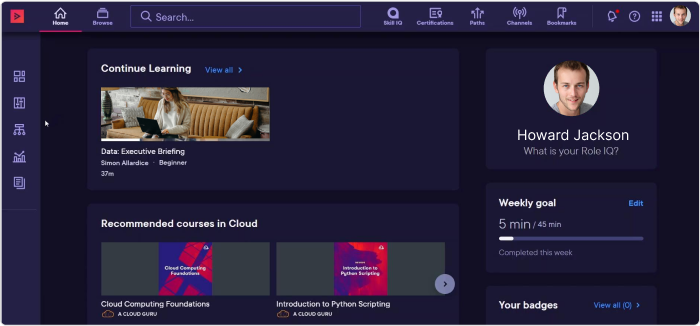
Pluralsight is a learning platform geared to help people develop critical tech skills. It offers a variety of IT courses (think software development, cyber security, coding, etc.).
Pros
- Extensive course library
- Offers skills assessment to help learners identify their strengths
- Offers flexible learning options, allowing learners to learn at their own pace
- Has 1,500+ expert instructors
- Relatively affordable
Cons
- Uses subscription-based pricing
- Very few free courses, so you have to pay for a subscription to access content
Who is it for?
- Learners seeking to gain tech skills: Pluralsight focuses on technology-related courses. So, if you seek courses in other fields, it’s not for you.
Why we picked it
Pluralsight offers many of the advantages of online learning platforms. When an online learning platform offers an extensive course library and an army of expert instructors, it’s worth mentioning. Pluralsight ticks these boxes.
Pricing
Pluralsight subscription membership cost:
- $19 per month
- $159 per year (a saving of almost $30)
10. Codecademy
G2 rating: 4.3/5 (168 reviews)
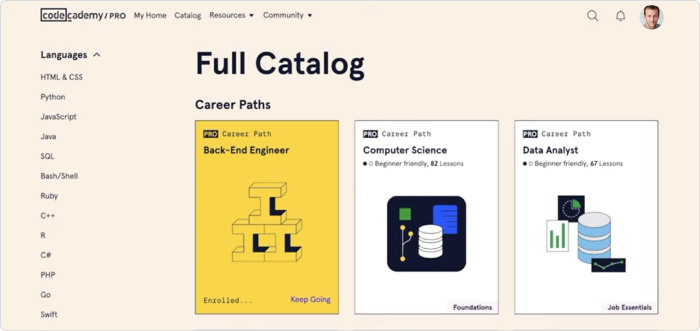
As the name suggests, Codecademy is an online learning platform that offers free coding lessons in various programming languages. It offers courses in the following languages: Python, Java, JavaScript, SQL, C++, C#, Ruby, PHP, R, Bash, HTML and CSS, and Swift.
It also offers courses in tech-related topics like computer science, web design, web development, and cybersecurity. With about 24 million users worldwide, millions of people are using Codecademy to learn to code for free. Plus, it’s a flexible platform that allows students to learn at their own pace.
Pros
- Beginner-friendly
- Offers interactive exercises
- Learning is self-paced, with no deadlines from instructors
- Learning is free (but there’s an affordable Pro plan)
Cons
- No live interaction with actual humans
- The quality of some courses may not be great, as anyone can create courses on the platform.
Who is it for?
- Students new to coding: Codecademy is a great platform for those who want to start coding. It offers concise and engaging tutorials that are guaranteed to make learning enjoyable for beginners.
Why we picked it
If you think coding is hard, Codecademy will change your mind. Codecademy focuses on engagement. Courses are succinct and easy to follow (even for complete beginners). In addition, students don’t need to install any software to try out each lesson.
Pricing
Codeacdemy’s pricing for individuals is:
- Basic plan: $0
- Plus: $14.99 per month
- Pro: $19.99 per month
Best Online Course Platforms in 2024
With online course platforms, you can make money online by selling your courses. However, you’ll want a platform that will not stress you unnecessarily in either the course creation or course marketing process.
That said, the best online course platforms are:
11. iSpring Market
G2 rating: 4.5/5 (3 reviews)

If you need a comprehensive eLearning platform for marketing, selling, and hosting your online courses, iSpring Market is the way to go. With its intuitive interface and high-converting marketplace, it’s the perfect choice for quickly getting your courses to market.
iSpring Market stands out as a unique eLearning platform due to its ability to effortlessly deliver engaging learning content in various formats, including audio, video, PowerPoint presentations, and SCORM packages. So, one key aspect of this platform that sets it apart is that it doesn’t limit you to passive learning through video content as many others do.
Instead, the courses you might offer through iSpring Market may come equipped with interactive, automatically graded quizzes, drag-and-drop, and drop-down interactions, as well as role-play simulations with branched scenarios.
And what’s even better is that it offers robust analytics and integrates seamlessly with Google Analytics.
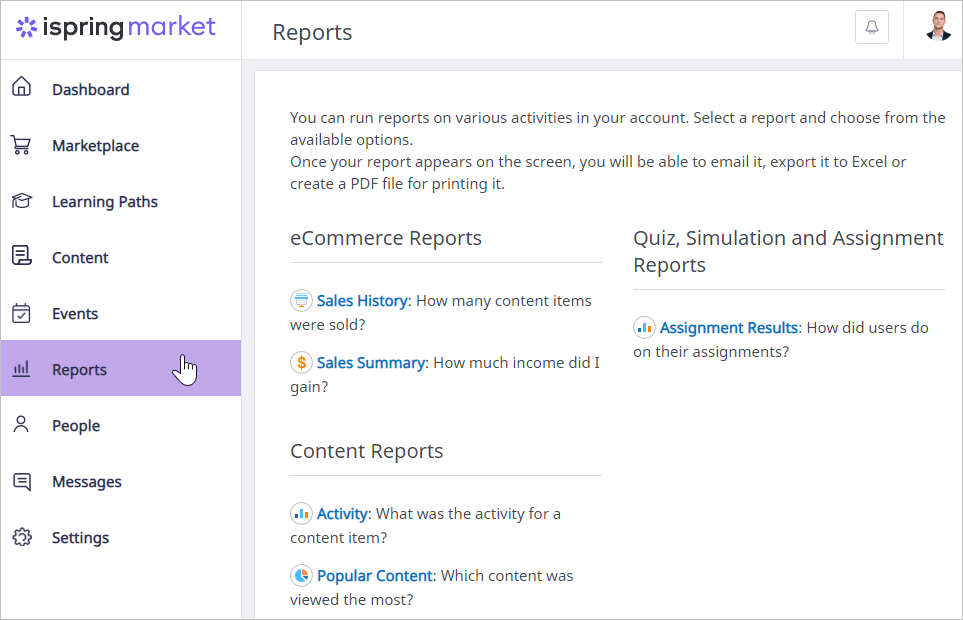
Detailed reports offer insights on customer acquisition, your earnings, your top traffic sources, and which courses are in demand.
Pros
- Maximum flexibility with course content types
- Can deliver courses with sophisticated interactions
- Gamified learning environment with points, badges, and leaderboards
- Drives sales by incentivizing with limited-time offers and coupons
- Issues certificates of completion
- Accepts various payment methods and currencies
- Detailed analytics to monitor learner engagement and progress
Cons
- Limited marketing options are available
- Admin features are basic in functionality
- Courses are not accredited
Who is it for?
- Course creators who want fewer restrictions: iSpring Market is a platform for course creators looking to develop diverse online courses with no limitations on content type or interactivity. With its user-friendly interface and extensive feature set, iSpring Market is the ideal choice for content creators who would like to swiftly bring their courses to market and generate income.
Why we picked it
iSpring Market is one of the few course platforms that supports SCORM. It enables instructors to deliver rich and interactive content, enhancing the overall learning experience. Besides, the platform offers strong user and content management functionalities, coupled with a comprehensive reporting system. iSpring Market essentially combines the benefits of both an LMS and an online marketplace.
Pricing
iSpring Market offers 4 pricing plans:
- 500 users (25 GB): $77/month
- 1,000 users (50 GB): $147/month
- 2,000 users (100 GB): $277/month
- Custom: Contact sales for a custom quote.
Offers a 14-day free trial.
12. Kajabi
G2 rating: 4.3/5 (76 reviews)
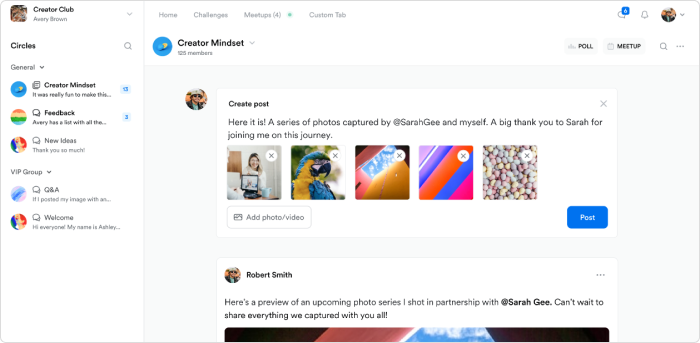
Kajabi places a stronger emphasis on selling online courses rather than content creation. Therefore, as an online learning platform, its sales and marketing features are notably more robust than its tools for course development.
For instance, Kajabi’s sales page templates enable you to create visually appealing storefronts that drive high conversion rates.
As for the course development tools it provides, you can upload video lectures and additional learning resources, such as worksheets and assessments, to complement each lesson. Furthermore, these tools enable you to create learning pathways with automation capabilities. For example, once a learner completes a set of lessons within a module, you can automate unlocking of the subsequent lessons based on pre-defined conditions.
But Kajabi’s most notable feature is its “sales pipelines,” which are also referred to as sales funnels. These pipelines direct users through the purchasing process efficiently, allowing you to monitor multiple buyers in a structured, visual, and strategic approach.
The ability to create custom pipelines allows you to oversee and manage every aspect of the sales process. For example, you can establish automated email sequences during the opt-in phase and monitor each stage of the pipeline closely to gain valuable analytical insights.
Pros
- Well-designed user interface and exceptional user experience
- A comprehensive solution from course development to sales
- Extensive customization options for branding and marketing
- Superb video streaming capabilities
- Beautifully crafted landing pages
Cons
- Lacks interactivity and student engagement features
- Doesn’t provide completion certificates
- Steep learning curve, particularly during setup
- Priced higher compared to many other competitors
Who is it for?
- Creators looking for a platform with good sales and marketing features: Many entrepreneurs and individuals pay a higher price for Kajabi since they expect to leverage its comprehensive sales and marketing features to turn a profit. It’s ideal for entrepreneurs and businesses that are keen to earn passive income by leveraging Kajabi’s automated lead generation, email marketing, and sales pipelines to achieve great numbers of learners.
However, given its relatively steep learning curve, Kajabi can be challenging for those less familiar with technology.
To use it effectively, it’s essential to be well-versed in Kajabi’s functionalities. If you’re dedicated to learning and interested in developing and marketing straightforward text- or video-based courses, this platform could be a good fit for your needs.
Why we picked it
There are three things we most like about Kajabi. First, its robust sales funnel builder empowers you to create diverse marketing funnels. Second, the platform’s advanced marketing automation functionalities enable you to trigger personalized emails. Finallly, Kajabi stands out due to its exceptional customization options.
Pricing
Kajabi has a 3-tier pricing model:
- Basic: $149/month
- Growth: $199/month
- Pro: $399/month
Offers a 14-day free trial.
13. Podia
G2 rating: 4.6/5 (21 reviews)
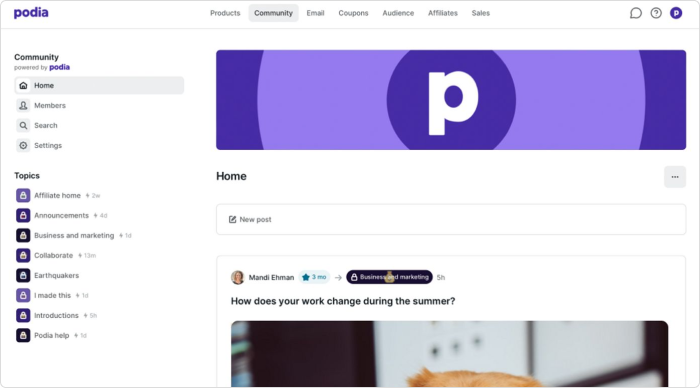
Podia is another all-in-one tool for course creation, marketing, and sales. It offers cost-effective learning solutions that are incredibly user-friendly. One of the reasons it’s made this list of the top online learning platforms is its creator-focused approach. You’d be hard pressed to find another platform that provides instant payouts and doesn’t charge transaction fees.
With most course platforms, your digital products and membership sites are hosted separately. With Podia, your memberships are seamlessly integrated within your digital storefront. This helps simplify the subscription process for customers and increase conversion rates.
However, Podia comes with no built-in course development tool. To create a course, you need to upload existing content, which can be in the form of eLearning modules, digital downloads like PDFs and audio files, or product bundles. So, to ensure a seamless course creation process, you need to prepare all of your content beforehand.
Podia primarily focuses on the sales and marketing aspects of business. For example, its email marketing capabilities are quite impressive. You can collect email addresses from both existing and potential customers through your storefront pages and then send them regular newsletters or notifications for drip campaigns.
In essence, Podia provides all the necessary tools to quickly set up your storefront and membership. But considering the cost, the offerings are quite basic. Still, it serves as an excellent starting point.
Pros
- Instant payouts
- No transaction fees
- User-friendly, simple design
- Membership site integrated with your digital storefront
- Unlimited use of resources (such as bandwidth and courses)
- Comprehensive email marketing tools
- Capabilities to track learner progress
Cons
- Limited customization options
- Lacks important educational features (such as graded quizzes and certificates of completion)
- Basic reporting and analytics abilities
- Limited selection of design templates for storefront pages
Who is it for?
Technologically challenged creators: Podia’s minimalist design and built-in features eliminate the learning curve for even the most technologically challenged among us. But, of course, this comes at a cost – a lack of control.
Creators seeking a platform with zero transaction fees: Podia’s creator-first approach makes it a top learning platform if you’d like instant payouts with zero transaction fees.
However, don’t expect much when it comes to sophisticated marketing tools, branding, and customization options. At its core, Podia is best suited for individuals with simple online course creation and marketing needs.
Why we picked it
Podia has earned its spot on our list as the top choice for people who want to get started with their course selling process. It’s a perfect solution for those who have no coding or design background and want to get the basic marketing tools needed to sell digital products.
Pricing
Podia has 3 pricing plans:
- Mover: $39/month
- Shaker: $89/month
- Earthquaker: $199/month
Offers a free 14-day trial.
Also read → 5 Podia Alternatives
14. Thinkific
G2 rating: 4.6/5 (216 reviews)
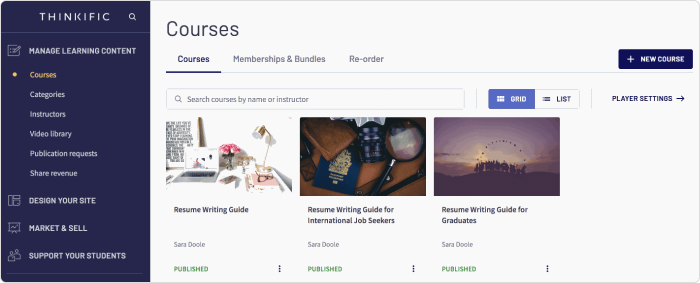
You’ve probably heard of Thinkific, as it is one of the biggest names in the eLearning space.
Thinkific lets you create, market, and sell your online courses while maintaining your brand identity. For example, its Site Builder tool offers three themes, providing room for branding customization, such as adding your own color scheme, fonts, images, and other media types.
The platform lets you structure your courses properly (into “Chapters” or “Modules”) and boasts a built-in quiz and survey builder.
Pros
- Intuitive platform with a minimal learning curve
- Has learner-focused course design features
- Offers good customization options
- Offers tons of third-party integrations
Cons
- To host videos, you must use third-party services like Wistia
- Does not support SCORM/AICC content, so you cannot sell courses with interactive quizzes
Who is it for?
- Businesses seeking a low-tech course platform: With its intuitive Site Builder tool, even the technologically challenged can use Thinkific to quickly create, build, and sell online courses.
Why we picked it
Thinkific’s simple drag-and-drop course builder makes it a winner. It’s designed to be easy to use for both new and experienced creators.
Pricing
Thinkific has four monthly plans.
- Free: $0
- Basic plan: $49 per month
- Start plan: $99 per month
- Grow plan: $199 per month
Note that Thinkific’s free plan is very generous compared to the restrictive plans of similar platforms.
15. Teachable
G2 rating: 4.0/5 (46 reviews)
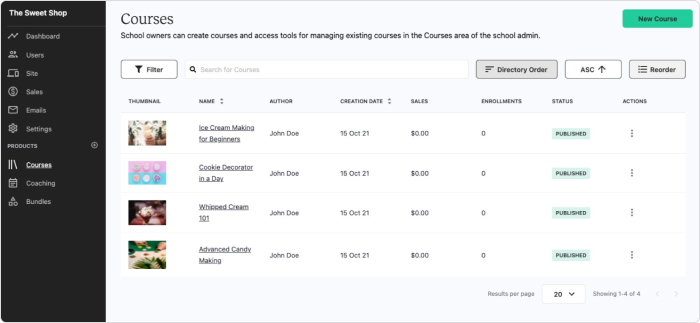
Teachable is an online course platform with many similarities to Thinkific. It’s a straightforward platform with a simple online course creation process. You simply upload your courses. Interestingly, it accepts the standard formats: PDFs, MP3 audio files, and videos.
You can organize courses into “sections” and “lectures” and use features like quizzes and comments to keep students engaged.
Pros
- Very user-friendly interface
- Lets you create structured courses
- Has a high-converting sales funnel
- Very affordable
Cons
- Offers only one theme
- Doesn’t support SCORM content
- Quiz-building options are limited (only multiple-choice)
Who is it for?
- Businesses looking for low-tech online course platforms: Teachable’s easy-to-use interface makes it a great option for creating and selling online courses, even with minimal tech skills.
- Businesses with tax and business management needs: Teachable has built-in business management and tax tools, making it easier for course creators who need to track and handle these processes.
Why we picked it
In addition to being user-friendly and easy to navigate, Teachable offers several e-commerce options. For example, it lets you sell your courses on a fixed-price, subscription, or membership basis. It also gives you several options to encourage potential buyers to take action, such as discounts and add-ons.
Pricing
Teachable has four plans:
- Free plan: $0 per month
- Basic plan: $39 per month
- Pro plan: $119 per month
- Pro+ plan: $199 per month
16. Gumroad
G2 rating: 4.1/5 (15 reviews)
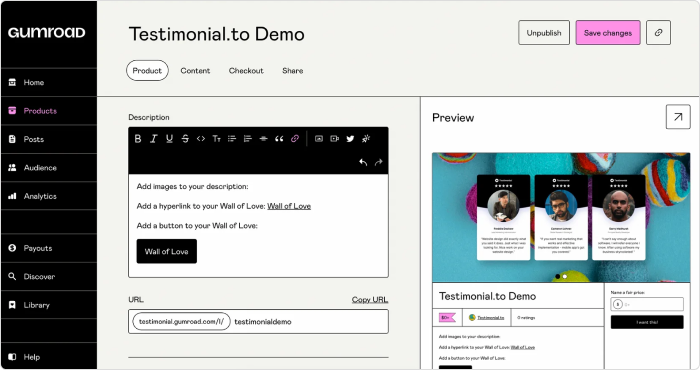
Gumroad is another platform to consider for selling courses online. It’s not as popular as the other online course platforms on this list. But that’s because it’s a platform that’s more geared toward selling digital products, not specifically online courses.
When selling using Gumroad, you’ll need to house all your courses within one digital product. As a result, you cannot incorporate interactivity into courses or structure them properly.
However, Gumroad comes with the advantage of taking care of your storefront and allowing you to sell via fixed-price, subscription, or preorder.
Pros
- Simple to use
- Supports several third-party integrations
- Highly affordable
- Allows for CSS customization
Cons
- Not specific to eLearning
- Course design features are limited
- Courses will have very basic interactivity
Who is it for?
- Beginner creators: Gumroad is perfect for people looking to sell just a handful of self-contained content, especially if they don’t want much involvement in the process.
Why we picked it
Gumroad is a simple shopping cart. True, it’s not for businesses that want to sell highly structured, full-fledged eLearning courses. But it’s a good place to get up and running with selling courses online. Plus, it’s very affordable.
Pricing
Gumroad offers two plans:
- Free: You pay only when you make a sale (fee is 8.5% of the sale amount + $0.30)
- Premium: $10 per month. (transaction fee per sale is 3.5% of the sale amount + $0.30)
17. EzyCourse
G2 rating: 5.0/5 (32 reviews)
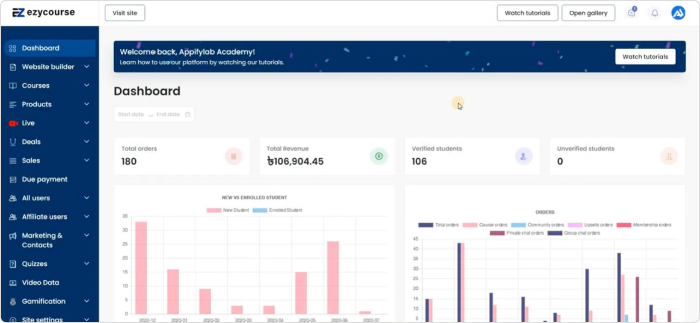
EzyCourse positions itself as a course platform that makes it easy to create and sell courses online.
You can create unlimited courses with different types of lessons. Know that you don’t even need a complete course before you can start selling. With EzyCourse’s “drip and pre-sell” feature, you can get going immediately.
They also have built-in quiz features, which you can use to make your courses more engaging. They also offer a credentialing solution, which allows you to offer certificates of completion to give your students a sense of achievement.
Pros
- Offers email marketing and landing page-building tools for course promotion
- Offers community features to engage and support students
- Flexible pricing options
Cons
- Pricing is relatively high and might be beyond the reach of small businesses.
- Limited integration with other tools.
Who is it for?
- Creators seeking a platform with lots of course promotion features: EzyCourse not only allows you to create courses easily, but it also arms you with a lot of features to promote the courses. Its email marketing and landing page-building features are two examples.
Why we picked it
EzyCourse ticks many of the boxes you’d expect a great course platform to have. It offers an easy course creation process, powerful lead generation tools, unlimited storage for course materials, and more.
Pricing
EzyCourse has five plans:
- Free plan: $0 per month
- Basic plan: $31 per month
- Pro plan: $65 per month
- Unlimited plan: $199 per month
- Elite plan: $399 per month
Best Learning Management Systems (LMSs) for Businesses
Want to equip your employees with the skills they need to work better? It’s not enough to create and deliver training programs. You also need to track employee progress in the training and ensure compliance with training requirements. A Learning Management System (LMS) for businesses helps you do this.
The best LMSs for business are:
18. iSpring Learn
G2 rating: 4.5/5 (78 reviews)
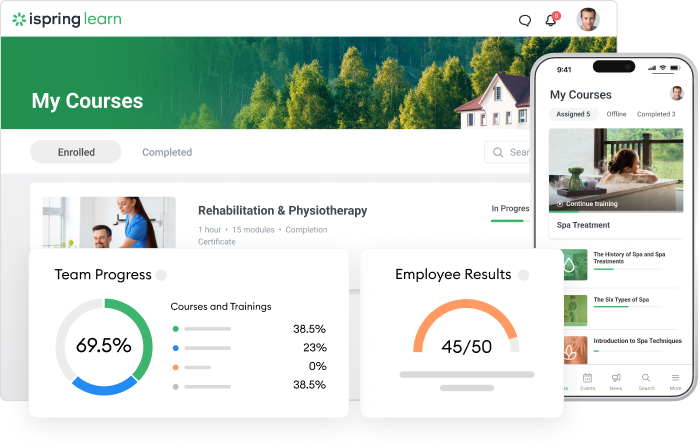
iSpring Learn is a comprehensive learning management system, loaded with both basic and advanced functionalities, all wrapped up in a user-friendly interface. Course creators and administrators can upload a wide array of training materials seamlessly, including videos, audio, reference documents, and interactive SCORM content, making them readily accessible to learners.
The platform’s dashboard is designed for ease of use; you can create multiple learning paths, configure your accounts and branding, and set permissions quickly and easily. It also offers an impressive array of user management features. For instance, you can arrange learners into groups, which is particularly important if you want to monitor their progress, outcomes, and level of engagement.
Moreover, iSpring Learn offers a “Rules” feature, which streamlines the assignment of content to learners based on their group, progress, or professional roles and allows you to automate what would otherwise be a labor-intensive process.
Perhaps the most distinctive offering of iSpring Learn is the inclusion of iSpring Suite, an advanced authoring tool, at no extra charge. Integrated directly into PowerPoint, iSpring Suite empowers users to create a wide variety of content types, from screencasts and talking head videos to slide-based courses and interactive role-plays.

Besides, the LMS has a built-in course builder that allows you to create page-like courses and quizzes in no time.
Pros
- Comes with a free, sophisticated authoring tool (iSpring Suite) as well as a built-in authoring tool for simpler courses
- Well-designed, intuitive user interface suitable for users of all tech skill levels
- Integration with video conferencing software such as Zoom and MS Teams
- Mobile app compatible with both Android and iOS devices
- 24/7 live support
Cons
- Lacks support for multi-tenancy
- No integration with Zapier
Who is it for?
- New and seasoned eLearning professionals: iSpring Learn is a solid LMS for both newcomers and experienced eLearning professionals. Its interface is sleek and user-friendly, eliminating the need for advanced technical skills. Furthermore, if you’re looking to develop new online courses, there’s no need to invest in extra authoring software. Overall, it’s awesome software for the forward-thinking training specialist.
Why we picked it
iSpring Learn is a training platform that masterfully blends functionality with ease of use. It stands out in the crowded field as one of the rare, if not the only, solutions that come with a robust course authoring toolkit right out of the box. This integration offers a comprehensive training solution, which allows you to create professional eLearning content and manage and monitor training progress efficiently.
If you’d like to monetize your courses, iSpring Learn offers a seamless solution. It can be integrated with your Shopify storefront, so your customers can effortlessly purchase and access your courses directly through your online store.
Pricing
iSpring Learn has two types of subscription: Start and Business, with Business coming with a set of advanced features and a tiered pricing model:
- 100 users (Start): $2.87 per user/month
- 300 users (Start): $2.29 per user/month
- 300 users (Business): $3.14 per user/month
- 500 users (Business): $2.83 per user/month
- 1,000 users (Business): $2.55 per user/month
- Custom: Contact sales for a custom quote.
Offers a 30-day free trial.
19. LearnUpon
G2 rating: 4.6/5 (131 reviews)
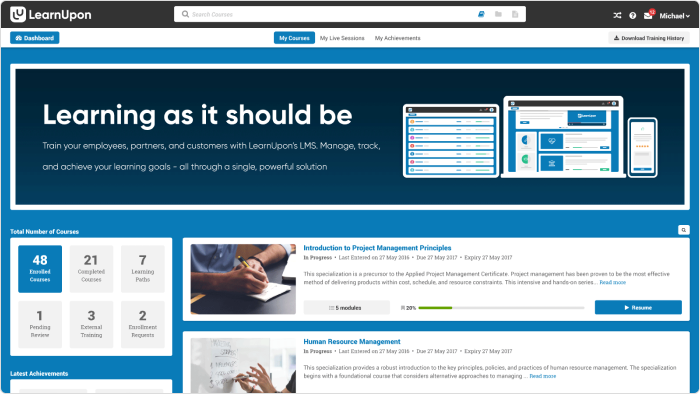
LearnUpon is a renowned player in the LMS industry. It boasts an array of powerful features typically not available in a single training software.
Beyond the basics of tracking, managing, and delivering training to employees and customers, it enables the creation of custom-branded digital storefronts for marketing and selling online courses. Moreover, it supports a range of content types including text, images, audio, videos, and slides, and complies with both SCORM and xAPI standards.
The LMS allows you to assign roles to customize training for specific groups and individuals. This user management feature not only personalizes training and professional development but also, when combined with LearnUpon’s sophisticated analytics, offers targeted insights for refining your training approach.
Speaking of tailored training, LearnUpon’s “learning portals” allow you to train diverse audiences through a single system. Think of LearnUpon as a macro-LMS, with each portal acting as a micro-LMS, customizable in style and branding to suit the specific learner group’s profile and requirements.
Pros
- Tailored training through learning portals
- Completion certificates
- Ability to create custom-branded digital storefronts
- Supports numerous integrations (Salesforce, Zapier, HubSpot, etc.)
- Compatible with a wide range of content types, including xAPI and SCORM
Cons
- Limited administrative flexibility
- Incompatibility with direct HTML5 course integration
- High cost
Who is it for?
- Creators of highly versatile content formats: While LearnUpon mainly targets businesses and also serves as an online educational learning platform, it’s most suited for creators of diverse content formats. Its innovative user management features, particularly the learning portals, make it ideal for those seeking a constantly evolving platform.
Why we picked it
LearnUpon made our list for its straightforward design paired with robust LMS capabilities. It’s a fairly easy-to-use training platform without too many bells and whistles that could hinder the user experience. Still, it allows you to customize your training program.
Pricing
LearnUpon’s pricing plan has 3 levels:
- Essential (150 active users, 2 portals): $1,249/month
- Premium (500 active users, 3 portals): $1,999/month
- Enterprise (500+ active users, 3+ portals): Contact sales for a custom quote.
Best Learning Management Systems for Schools and Colleges
Learning management systems (LMSs) for schools provide a centralized place for student-teacher interaction and help instructors track students’ learning progress in the interest of obtaining better learning outcomes.
The best LMSs for schools and colleges are:
20. Blackboard Learn
G2 rating: 3.9/5 (842 reviews)

Blackboard Learn is a truly veteran eLearning company. Launched in ’99, it’s been going strong for 23 years now. During this period, it has attracted more than 100 million learners.
Despite its name, it serves not only for K–12 and higher education sectors but can also be leveraged by governments and businesses.
Blackboard Learn offers a broad selection of educational tools but remains user-friendly. It enables educators to build and manage online courses, deliver assessments with automatic grading, and interact with students.
The learning management platform supports both live and self-paced training. Similar to LearnUpon, it offers learning portals that provide tailored training experiences for various learner groups.
A standout aspect of Blackboard Learn is its comprehensive range of integrations. That’s because the user interface is quite simple, making it easy to navigate, though it might seem too basic without the addition of third-party plugins.
On the bright side, the extensive compatibility with numerous plugins means there’s vast potential. There are a lot of plug-ins available for enhanced reporting, community engagement, and more. However, if you want to sell or market your courses, you’ll need another solution. And so it goes with academic LMSs.
Pros
- Provides seamless two-way communication between teachers and students
- User-friendly for both learners and educators
- Wide selection of plug-ins to enhance functionality
- Blackboard SafeAssign plagiarism detector
Cons
- No capability to market or sell courses
- Requires improvements in user experience and design
- Mobile app functions but is a bit ‘buggy’
- Initial setup is difficult and time-consuming
Who is it for?
- Teachers in K–12, high school, and post-secondary schools: Because of Blackboard’s heavy academic bent, it’s great educational software for K-12, high school, and post-secondary learning environments. It facilitates student engagement, collaboration, and access to course material.
Why we picked it
We consider Blackboard to be a solid LMS for the academic sector. It’s a robust solution that offers a sturdy system to faculty members so they can share materials in one spot, communicate with students easily, and give out grades online.
Pricing
Starts at $9,500 per year. Contact sales for a custom quote.
Has a free 30-day trial.
21. Canvas
G2 rating: 4.4/5 (1,480 reviews)
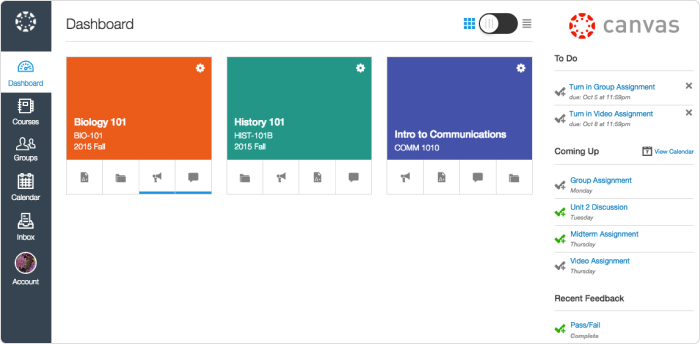
Being a newer alternative to Blackboard, Canvas is another online learning software
with a strong emphasis on academic use. Yet, it’s also popular among online educators for building standalone courses not tied to any institution or company.
One of the best features is its exceptional versatility in accommodating various learning formats. And unlike Blackboard, Canvas offers the ability to create websites to host your courses. This gives you considerable freedom to customize your site according to your needs. Moreover, Canvas comes equipped with all the essentials — from quizzes and grade books to reporting tools and integrations — to ensure that users remain on the right track.
With its vast array of integrations, including Microsoft Teams, Google Workspace, and Adobe Creative Cloud, you can do almost everything under one roof. This is crucial for course development teams that are spread out but need to collaborate in real time and see each other’s progress.
Speaking of progress, Canvas’ SpeedGrader feature simplifies the task of grading assignments and submissions that require manual evaluation. While Canvas may not be as strong in gamification as many of its competitors, it offers a unique advantage with its vibrant social learning community.
Educators can interact with students via audio and video, as well as send messages individually or in bulk. It also provides numerous tools for student collaboration, including discussion boards, video conference workshops, and shared online resources, which allow them to connect with each other.
Pros
- Everything you need in a single software solution
- Extensive range of integrations
- Robust social learning and collaboration functionalities
- SpeedGrader for the efficient grading of assignments and submissions
Cons
- A steep learning curve to fully leverage the platform’s capabilities
- Little to no gamification features
Who is it for?
- Users who want a platform with multiple interfaces: Canvas’ “learning portals” make it great for users seeking to create multiple interfaces, each tailored and branded for distinct audiences. For basic tasks, Canvas is quite user-friendly. However, to fully harness its capabilities, you’ll need to invest time in climbing the learning curve.
Why we picked it
We regard Canvas as an excellent LMS for schools, districts, and universities. We especially appreciate it for its built-in tools designed to enhance interactions and streamline communication with students. With a variety of communication tools available, each offering unique functionalities, Canvas stands out for its flexibility in facilitating dialogue and engagement.
Pricing
Canvas has both a paid and a free option.
- Free: The free account unlocks many essential features, including creating courses, quizzes, and video conferences, creating tailored learning via Mastery Paths, access to the Canvas mobile app suite, and integration with third-party apps.
- Paid: Contact sales for a custom quote.
22. Moodle
G2 rating: 4.1/5 (391 reviews)
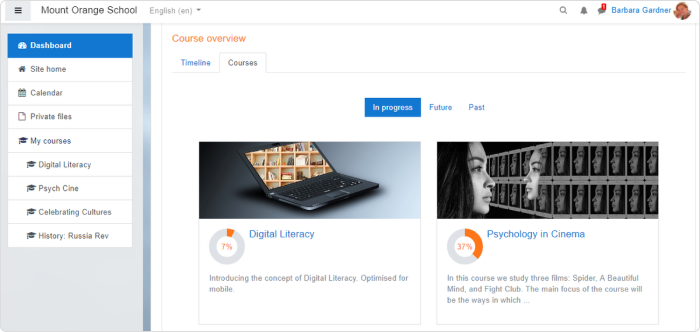
When it comes to free online learning tools, Moodle is a titan in the open-source LMS landscape, and its cost-free nature is just the beginning. It not only enables instructors to host their own websites, but it also comes with robust learner-focused software, a wide array of plug-ins, and dynamic social learning spaces that benefit both students and teachers.
As a full-fledged eLearning LMS, Moodle is equipped with a comprehensive suite of features. It allows learners to progress through courses at their preferred pace, participate in real-time online classes, and benefit from a blended learning approach for maximum flexibility. Moreover, Moodle makes it very easy to incorporate gamification elements such as points, badges, achievements, and leaderboards to boost user engagement.
And what truly sets it apart is that you’re not limited to conventional slide-based or video courses that often suffer from low interactivity. Thanks to its SCORM compliance, Moodle allows the uploading of eLearning content with complex interactions, such as simulations, branched scenarios, and 3D virtual learning environments, making it one of the premier online platforms for interactive learning.
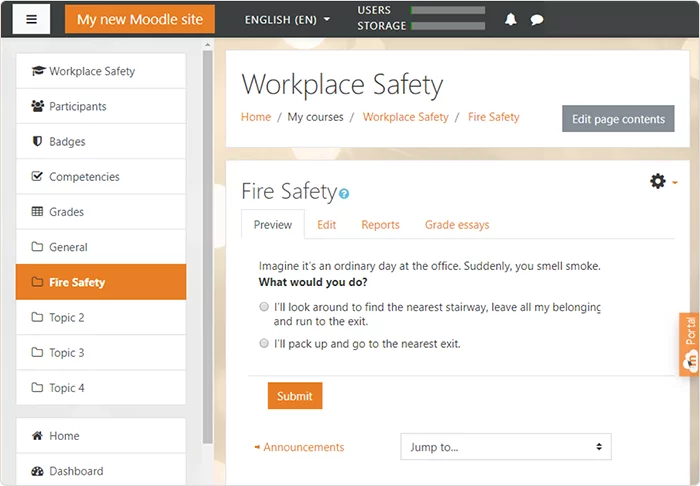
In addition, Moodle supports a vast range of plug-ins, extending its functionality even further. For example, if you’d like to turn your website into an eCommerce platform, you can integrate with WooCommerce or Course Merchant. Given that Moodle is a cost-free software, renowned and primarily designed for eLearning, exploring its capabilities comes with no downside. If anything’s missing, there is most definitely a plug-in that can add that functionality.
Pros
- Highly customizable; there are hundreds of parameters and settings to choose from
- Includes a robust mobile application for on-the-go access
- Built-in assessment tools with a quiz bank that can randomize questions
- Supports integration with H5P, which enables highly interactive content
- Allows you to deliver online classes
Cons
- Reporting and analytics capabilities are somewhat limited
- Its learning curve is steep for newbies
- The interface may appear cluttered and overwhelming for beginners
- Doesn’t offer learning paths
Who is it for?
- Instructors in educational institutions from K–12 to multi-campus universities: Moodle is most suited for academic contexts, especially thanks to its support for SCORM content and solid user management features.
For businesses or organizations looking to expand and train their workforce, the standard Moodle LMS might not meet all the needs. To accommodate such scenarios, Moodle has developed “Moodle Workplace,” tailored specifically to corporate training requirements.
However, this doesn’t mean Moodle falls short for government use, small entities, or non-profit organizations. In fact, its competitive edge — being free of charge — makes it an appealing choice, especially when considering the comprehensive range of features it offers.
Why we picked it
Moodle is considered to be a top LMS for the academic sector, and we agree entirely. Boasting an extensive array of tools designed to engage students in online training, it serves as the perfect platform to transition your classroom into a modern eLearning landscape.
Pricing
Moodle is a free learning software. However, hosting your Moodle site will cost money, as will certain third-party integrations.
Also read: How to Create a Moodle Quiz: Step-by-Step Guide
23. Google Classroom
G2 rating: 4.5/5 (1,440 reviews)
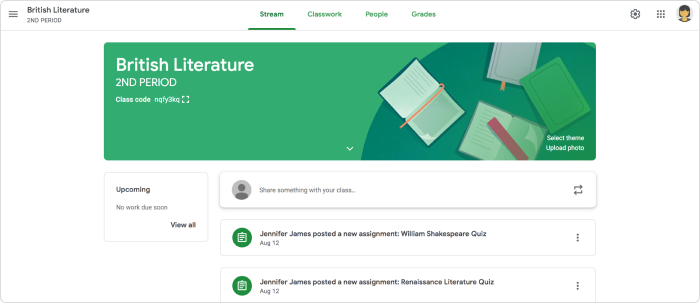
Google Classroom is a learning management system developed by Google for educational institutions to help teachers create, distribute, collect, and grade assignments paperlessly.
It combines Google Drive, Google Docs, and Gmail to streamline file sharing between teachers and students.
Using Google Classroom, teachers can create a separate folder in Google Drive for assignments and invite students to join. Students will submit completed assignments to the drive, where teachers can access them for grading.
Pros
- User-friendly interface
- Accessible from all devices
- Helps teachers stay organized
- Improves class communication
Cons
- Limited interaction options
- Sharing files between learners can be difficult
- Doesn’t provide automated quizzes and tests for learners
- Students who are made editors of files can edit it
Who is it for?
- Teachers seeking paperless assignment submission: Google Classroom streamlines document management, allowing teachers to create and collect assignments paperlessly. This is especially helpful for distance learning.
Why we picked it
Google Classroom is great for organizations. The teacher creates folders in their Drive for each class, and each class gets folders for each assignment. So, it’s easy to go back and review previous or a specific student’s work.
Also, Google Classroom now integrates with Google Meet, allowing teachers to use video meetings (and all of Meet’s education-centric features like hand-raising and polls) to improve the learning experience.
Pricing
Google Classroom has four plans:
- Education Fundamental: $0
- Google Workspace for Education Standard: $3 per student per month
- Teaching and Learning Upgrade: $4 per license per month
- Google Workspace for Education Plus: $5 per student per month
How We Tested Online Learning Platforms, Course Platforms, and LMSs
To create this in-depth review of learning platforms, we test-drove all the solutions that provide free trials.
We delved into their features and compared their capabilities, assessed the user interfaces for ease of use, and discovered how well each platform’s features align with the needs of their intended users.
Also read → The Top 9 Learning Management System Features Every LMS Must Have
For platforms without free trials, we carefully reviewed their documentation and viewed demo videos to ensure a thorough evaluation.

